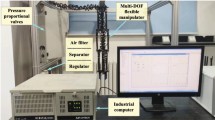Abstract
Multi-degree-of-freedom pneumatic manipulators are prone to time delay for influence of joint disturbances during position servo, resulting in poor robustness of position servo control of multi-degree-of-freedom pneumatic manipulators, so in order to improve the robustness of position servo control of multi-degree-of-freedom pneumatic manipulators, a method of position servo robustness control for multi-degree-of-freedom pneumatic manipulators based on delayed feedback is proposed. In this method, a sensor array is adopted to acquire position servo parameters of a multi-degree-of-freedom pneumatic manipulator, and a controlled object model for position servo control of the multi-degree-of-freedom pneumatic manipulator is constructed to adjust control constraint parameters. Based on this model constructed, the time-delay coupling tracking compensation method is adopted to adjust position error of the multi-degree-of-freedom pneumatic manipulator, and the inertial attitude parameter fusion method is adopted to correct control error of the manipulator, so as to optimize position servo control output of the manipulator. Simulation results show that this method has advantages of small error, good stability and posture error correction performance in position servo control of multi-degree-of-freedom pneumatic manipulators.






Similar content being viewed by others
REFERENCES
Hou Che, Wang Zheng, Zhao Yiwen, and Song Guoli, Load adaptive force-free control for the direct teaching of robots, ROBOT, 2017, vol. 39, no. 4, pp. 439–448.
You, Y.P., Zhang, Y., and Li, C.G., Force-free control for the direct teaching of robots, J. Mech. Eng., 2014, vol. 50, no. 3, pp. 10–17.
Uijlings, J.R.R., van de Sande, K.E.A., Gevers, T., et al., Selective search for object recognition, Int. J. Comput. Vision, 2013, vol. 104, no. 2, pp. 154–171.
Zhang Danfeng, Li Bin, and Wang Liyan, Tracking control method of the centre-of-mass velocity for a snake-like robot based on the continuum model, ROBOT, 2017, vol. 39, no. 6, pp. 829–837.
Li Ke and Mi Jie, Research on mechanical and electrical control algorithm of bionic robot based on variable structure PID, J. Henan Univ. Eng.,Nat. Sci. Ed., 2016, vol. 28, no. 2, pp. 32–37.
Du Xuedan, Cai Yinghao, Lu Tao, Wang Shuo, and Yan Zhe, A robotic grasping method based on deep learning, ROBOT, 2017, vol. 39, no. 6, pp. 820–828, 837.
Ren, Z.W., Zhu, Q.G., and Xiong, R., A joint physical constraints avoidance method for inverse kinematics problem of redundant humanoid manipulator, J. Mech. Eng., 2014, vol. 50, no. 19, pp. 58–65.
Jing Fengshui, Yang Chao, Yang Guodong, and Tan Min, Robot trajectory rectification control methods, ROBOT, 2017, vol. 39, no. 3, pp. 292–297.
Du Xuedan, Cai Yinghao, Lu Tao, Wang Shuo, and Yan Zhe, A robotic grasping method based on deep learning, ROBOT, 2017, vol. 39, no. 6, pp. 820–828, 837.
Varley, J., Weisz, J., Weiss, J., et al., Generating multi-fingered robotic grasps via deep learning, IEEE/RSJ International Conference on Intelligent Robots and Systems, Piscataway, 2015, pp. 4415–4420.
Zeiler, M.D. and Fergus, R., Visualizing and understanding convolutional networks, 13th European Conference on Computer Vision, Berlin, 2014, pp. 818–833.
Ren, S.Q., He, K.M., Girshick, R., et al., Faster R-CNN: Towards real-time object detection with region proposal networks, in Advances in Neural Information Processing Systems, Cambridge: MIT Press, 2015, pp. 91–99.
Jiang, Y., Moseson, S., and Saxena, A., Efficient grasping from RGBD images: Learning using a new rectangle representation, IEEE International Conference on Robotics and Automation, Piscataway, 2011, pp. 3304–3311.
Krizhevsky, A., Sutskever, I., and Hinton, G.E., ImageNet classification with deep convolutional neural networks, in Advances in Neural Information Processing Systems, Cambridge: MIT Press, 2012, pp. 1097–1105.
Maitin-Shepard, J., Cusumano-Towner, M., Lei, J., et al., Cloth grasp point detection based on multiple-view geometric cues with application to robotic towel folding, IEEE International Conference on Robotics and Automation, Piscataway, 2010, pp. 2308–2315.
Johns, E., Leutenegger, S., and Davison, A.J., Deep learning a grasp function for grasping under gripper pose uncertainty, IEEE/RSJ International Conference on Intelligent Robots and Systems, Piscataway, 2016, pp. 4461–4468.
Zeng Xiangxin, Cui Naigang, and Guo Jifeng, Path planning of space robot based on hp-adaptive pseudospectral method, ROBOT, 2018, vol. 40, no. 3, pp. 385–392.
Liao, Y.H., Li, D.K., and Tang, G.J., Motion planning of space manipulator system based on a hybrid programming strategy, J. Astronaut., 2011, vol. 32, no. 1, pp. 98–103.
Darby, C.L., Hager, W.W., and Rao, A.V., An hp-adaptive pseudospectral method for solving optimal control problems, Optim. Control Appl. Methods, 2011, vol. 32, no. 4, pp. 476–502.
Ren Shuai, Zhang Tao, Xu Zhenchao, Wang Zhen, He Yuan, and Liu Yunong, Information hiding algorithm for 3D models based on feature point labeling and clustering, J. Comput. Appl., 2018, vol. 38, no. 4, pp. 1017–1022.
Funding
This work was supported by Henan Provincial Education Department Foundation under grant no. Young key teachers, and National Natural Science Foundation of China under grant no. 2015GGJS-202.
Author information
Authors and Affiliations
Corresponding author
Ethics declarations
The authors declare that they have no conflicts of interest.
About this article
Cite this article
Wang Hongying, Liu Shiping Position Servo Control Method for Multi-Degree-of-Freedom Pneumatic Manipulators Based on Delayed Feedback. Aut. Control Comp. Sci. 54, 10–18 (2020). https://doi.org/10.3103/S0146411620010058
Received:
Revised:
Accepted:
Published:
Issue Date:
DOI: https://doi.org/10.3103/S0146411620010058




